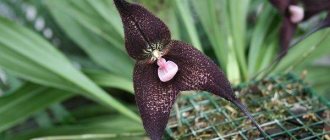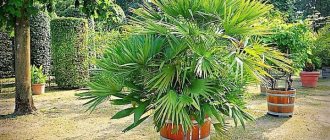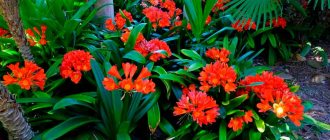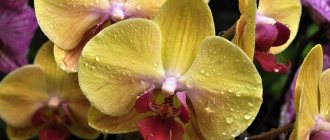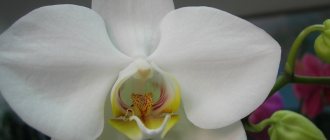The phalaenopsis orchid is rightfully considered one of the most common plants in home floriculture.
This is facilitated by the extraordinary variety of colors and shapes of flowers, abundant and lush flowering, and ease of care. Knowledge of the growing conditions of these tropical plants and compliance with the rules for their maintenance are a condition for good growth and regular flowering of the orchid.
In this article we will look at one of the unusual species of phalaenopsis called Phalaenopsis Giant.
Giant phalaenopsis orchid
Giant Phalaenopsis (Phalaenopsis gigantea) is the largest representative of monopodial orchids of the Phalaenopsis genus.
It received its name for its unusually large drooping leaves , reaching a length of 1 m.
A distinctive feature of the giant phalaenopsis is its large leaves.
Like all orchids, giant phalaenopsis is an epiphytic herbaceous perennial , perfectly adapted to growing in tropical forests.
Dimensions
An unusual flower grows on a ficus tree. Each of its inflorescences reaches up to three meters in length. The flowers covering the inflorescence reach up to 15 centimeters in diameter. Incredibly, there can be a very large number of flowers - from 60 to 100. The giant does not bloom every year, but the flowering period can last for several months. The giant orchid weighs approximately 2000 kilograms.
Features of the view
The stem is shortened, hidden under the bases of the leaves. The roots are fleshy, smooth, dense.
The leaves are leathery, very wide, drooping, with a shiny surface, rounded at the ends. An adult plant has 2-3 pairs of leaves about 0.6 m long, up to 0.4 m wide, sometimes the leaf length reaches 1 m.
The peduncle is hanging, curved, prone to branching, grows in length up to 0.3-0.4 m, bears from 10 to 30 flowers.
The flowers are fleshy, dense, with a diameter of 3.5 to 7 cm; thanks to the petals of the same size, they have a regular round shape.
The color of the petals is presented:
- Light cream,
- Green-yellow,
- Yellow color,
There are numerous red-brown lines , which can be easily felt with your fingers.
Phalaenopsis gigantea.
The flowers have a light citrus aroma . An adult orchid can easily form up to 100 flowers on several flower stalks.
Angrecum one and a half feet (Angraecum sesquipedale)
This is the largest species of orchid from the genus Angrecum. Plant of monopodial type. Forming trunk up to a meter in height, erect. The leaves are two-rowed, completely conceal the stem, folded at the base, with blunt ends. There is a dense waxy coating on the gray-green leaf blades. The shape is elongated, about 35 cm long, 3 cm wide. It produces 3-5 peduncles shorter than the leaves. The inflorescence contains from 2 to 6 flowers.
The flowers are in the shape of a large star, about 17 cm in diameter. This species has the most intense night aroma, pleasant, with a powdery trail. Solid, creamy white color. The shape of the lip is lanceolate, with a sharp tip and a long (up to 30 cm) light green spur.
Angrecum one and a half feet is called the comet orchid or the star of Madagascar.
There is an interesting story associated with the plant. In 1862, Charles Darwin, studying the structure of the flower, suggested that it could only be pollinated by a large night hawk moth. A new subspecies of the insect was discovered in 1903 and the specific epithet “praedicta” was assigned to it.
Habitat
The homeland of this extraordinary plant is Fr. Borneo in Indonesia .
Giant phalaenopsis grows high in the canopy of trees growing in tropical forests on mountain slopes.
This region is characterized by the absence of seasonal fluctuations in temperature and humidity : the range of daily temperature changes is within 23℃ at night and 30℃ during the day, relative air humidity: 80-86%.
The natural growing conditions of the giant phalaenopsis have left their mark on the care of this plant when kept indoors.
When you type in a photo of “gigantella” in the search, you will have to try to find a picture of a natural orchid, since there is no limit to the crossing of giants and there are a lot of photos of hybrids.
Variety and appearance
The largest orchid on the planet grows in Indonesia. It belongs to the variety Grammatophyllum speciosum, also called “Tiger Orchid”. The plant got its name due to its unusual coloring: its flowers are yellow, covered with red-brown spots.
In appearance, the tropical beauty resembles sugar cane. Therefore, one of its unofficial names is “sugarcane orchid.”
This is not the only name for the orchid. She is also called the “Queen of Orchids”. This is a well-deserved title, since the flower truly stuns the imagination both with its beauty and gigantic size.
Read about different rare and unusual varieties of orchids here.
History of discovery
Phalaenopsis giant was discovered at the end of the 19th century by the naturalist Nyvenhuis. He transported the plant to the botanical garden of the city of Buitenzorg, where the orchid first bloomed in 1909.
The unusual plant was described by the director of the botanical garden, J. Smith, after which the plant soon died .
During the construction of the road to the island. Barneo in 1937, the giant phalaenopsis was found again .
Currently, as a result of human economic activity, this species has been practically destroyed in its natural habitat.
Where is it found in nature?
The plant grows in Indonesia and Malaysia and loves a humid, hot tropical climate. It loves higher places. The most optimal option for flowering is an altitude of 1000 - 1200 meters above sea level.
The largest flower on the planet is located in the Indonesian Botanical Garden near Jakarta. As mentioned above, it lives on ficus, but does not parasitize on it. The queen orchid receives nutrients from the external environment.
Find out more about where orchids grow in nature and how they are classified in this material.
Features of flowering
This type of phalaenopis is considered one of the most demanding in culture. It is characterized by very slow growth, which is why the cost of adult specimens is extremely high.
In nature, the plant blooms after 6-12 years , but with proper care in cultivation, this period can be significantly reduced and amount to about 4-5 years. The first flowering of an orchid can be expected when the length of the leaf blade reaches 25 cm.
Important! If you decide to purchase this extraordinary plant for your collection, choose, if possible, the oldest specimen.
Peak flowering of the giant phalaenopsis occurs in late summer and early autumn , although it can bloom at any other time of the year. Flowering is long, up to 25-30 days, without a pronounced dormant period.
Photo of a blooming Gigantea, which grew in a greenhouse at t=27 C and 75-98% humidity during the day. The largest flower is 5 cm. More photos of this handsome flower from its owner can be found on the forum.
And this is what the giant’s flower looks like from the photo above.
A faded flower stalk should not be cut off , since the old flower stalk is characterized by repeated flowering.
Giganteas are record holders in “non-blooming”
It takes 9-12 years for natural giants to bloom. Flowers appear when the leaves reach a length of at least 15-20 cm. In greenhouse conditions and under the right conditions, plant growth is significantly accelerated. Often the waiting time for flowering is reduced by almost half. And the period of enjoying beautiful flowers reaches several months. Peak flowering usually occurs at the end of summer - beginning of autumn. But this possibility is possible at any time of the year. The peculiarity of the orchid is that flowers can continue to develop on the old peduncle.
Very beautiful long-flowering hybrids are regularly created on the basis of this handsome giant, impressive in its size. Gigantea easily crosses with the most colorful and vibrant representatives of its species, such as Phal. bellina, Phal. amboinensis and others. Many of the hybrids have received awards from reputable exhibitions.
This phalaenopsis has a number of features. Likes to sit in loose sphagnum, so that the roots develop freely inside the pot. When watering it, it is not necessary to soak the entire container in water if the humidity, for example, in a greenhouse does not fall below 60-80%. In this case, the plant does not need to be “watered” excessively so that it remains moist for a long time. It is enough to spray the moss with a spray bottle so that it is wet on one side. The moisture will be distributed throughout the pot and the flower will receive the amount of water it needs.
It is generally accepted that Phal. gigantea is difficult to grow. Rather, the flower requires adherence to certain principles in care.
Landing
Thanks to its decorative properties and the ability to easily cross with other varieties and hybrids , giant phalaenopsis has gained immense popularity and is successfully grown in botanical gardens, greenhouses, and also in apartments.
Priming
Like all orchids, it loves light, nutritious, breathable soil. When transplanting, the substrate should easily fall off from the roots .
As a rule, it consists of:
- Pieces of pine bark 2-3 cm in size;
- Expanded clay;
- Wood (preferably birch) charcoal;
- Whole sphagnum moss.
also purchase a ready-made substrate in a specialized store by adding a few threads of whole moss to it.
Sometimes phalaenopsis in a basket is grown on pure New Zealand moss . In such a substrate, the plant can grow without replanting for many years.
Optimal capacity
Plant a giant phalaenopsis in an orchid pot , basket or on a block.
A transparent pot for the still little Giant.
When choosing a pot, you should pay attention to its characteristics:
- Mandatory presence of drainage holes;
- The volume of the pot should be such that the roots are freely located and do not touch the walls;
- The material of the container must have good heat-insulating properties, otherwise the roots will overheat;
- Transparent walls will allow you to observe the condition of the root system.
A giant phalaenopsis planted in an orchid basket or block looks very impressive , since in this case its growth is similar to growing in natural conditions.
However, it must be borne in mind that growing on a block is inconvenient due to the large size of the plant and the need for daily watering.
Craftsmen also cultivate Giant Phalaenopsis entirely in water.
Growing Gigantea in water.
And here is a video on this topic, albeit in English (about growing in water starts approximately from the middle of the video):
F. Stuart (Phalaenopsis Stuartiana)
Growth.
Endemic to the island of Mindanao (Philippines).
Description history.
The species was discovered in 1881 by the Englishman William Boxall, an employee of the company Hugo Lowe and Co. (“The Orchid Review” November 1910).
Named after the co-owner of this company, orchid researcher Stuart Low. Heinrich Gustav Reichenbach, when describing the plant, wanted to name it in honor of the discoverer, but for unknown reasons he changed his mind and named it Pha. stuartiana.
Biological description.
Monopodial epiphyte of medium size. The stem is short, hidden by the bases of 2-6 leaves. The roots are smooth, thick, well developed. Sometimes “babies” form on them.
The leaves are green, oblong-elliptical, obtuse at the end, with a beautiful gray-green marbled pattern, 20-45 cm long, 9-10 cm wide. With age, the leaves become more uniform. The leaves have a purple tint on the underside.
Peduncles more than 60 cm, crimson or brown-green in color, racemose or paniculate, capable of bearing several dozen flowers. In record cases, more than 100.
The flowers open almost simultaneously. The flowers are 5-6 cm in diameter, slightly fragrant. The dorsal sepals and petals are white, the lateral sepals are bicolored. The halves facing up are white, those facing down are yellow with numerous purple spots. The lip is three-lobed, yellow with purple spots.
The lifespan of a flower is about a month. Flowering specimens can be found all year round, with peak flowering from February to April.
Peculiarities
The roots of giant phalaenopsis are very sensitive to injury , so transplantation is done only if necessary.
is replanted every 3 years after flowering has ended. The best time to transplant is the warm season, when it grows intensively.
Important! Planting is carried out in such a way that all the leaves of the plant hang down. This will protect the growing point from stagnant moisture after watering. Otherwise, transplantation is carried out according to the same rules as for other types of phalaenopsis.
After transplanting, it is recommended not to water the orchid for 2 weeks so that the plant adapts to the new conditions.
F. Ambonsky (Phalaenopsis amboinensis)
Growth.
Ambon, Sulawesi, Papua New Guinea and Indonesia.
Description history.
It was described in 1911 from specimens collected in the Moluccas.
Biological description.
There are 3-4 leaves in nature, 4-6 in culture. The leaves are elliptical in shape, 14-25 cm long, up to 10 cm wide.
Peduncle up to 45 cm, sometimes the orchid produces 2-3 peduncles. “Revolving” type of flowering , when one flower fades, the peduncle lengthens somewhat and a new bud appears.
All flower segments are cream, yellow or yellow-greenish, sometimes tinted orange, with brown-red transverse strokes. Flower diameter up to 6.5 cm.
Many clones have a pleasant aroma.
Sepals are elliptical in shape, with curved tips. Petals of similar shape, somewhat shorter. The lip is triple, about 2.2 cm long, the lateral parts are straight, yellow, the front part is white-green, elliptical-oval.
It can bloom at any time of the year, more abundantly in summer.
Care
The giant phalaenopsis is very indoor conditions
Optimal conditions of detention
For good growth and normal flowering when kept indoors, it must be provided with favorable growing conditions:
- The optimal cultivation temperature is in the range of 22-30℃ with a mandatory daily temperature fluctuation of 5-8℃. The plant does not tolerate well if the room temperature drops below 15℃;
- Lots of diffused light, much more than most other orchid species. In winter, the orchid is placed on the brightest window, as it grows all year round;
- The required indoor air humidity is 60-85%. To maintain optimal humidity, you can use a humidifier or place the orchid pot on damp expanded clay;
- The plant loves good air circulation so that moisture quickly evaporates from the leaves.
If you create favorable conditions for the giant phalaenopsis, it will reward you with good growth and extraordinary flowering .
Here's another giant. Other photos and description of this specimen can be found here.
Advice! If the orchid is not growing well, pay attention to the lighting. The right location plays an important role in the health and well-being of the plant.
Replanting after purchase
After purchase, phalaenopsis is not recommended to be replanted . This can only be done if rotten roots are visible.
It is better to place the plant in diffused light , away from other indoor plants. At first, it is not recommended to water or feed it .
If no diseases are detected during quarantine, then after 10 days the plant can be placed in a permanent place and watered.
Watering and fertilizing
Like other types of orchids, giant phalaenopsis is very sensitive to watering:
- Water the phalaenopsis as the substrate dries. It is better to do this in the morning so that the water that remains on the leaves dries by the evening. Watering is carried out once every 7 days, and care is taken not to cause waterlogging of the substrate;
- To water, place the pot with the plant in a container filled with water to 2/3 of the height of the pot and leave to stand for 15 minutes. After the roots are saturated with water and have acquired a bright green color, the pot is placed on the surface for 30 minutes to allow the water to drain;
- A good outflow of water can be ensured by placing the pot at an angle of 35-40°;
- If there is insufficient lighting in winter, the regime of watering and feeding the orchid is reduced.
Attention! It is necessary to ensure that water does not accumulate at the growth point of the giant phalaenopsis, as this can lead to rotting of the orchid.
Fertilizing is carried out with highly diluted orchid fertilizer.
For phalaenopsis growing on different substrates, different types of fertilizers are used:
- On a substrate of living sphagnum moss, foliar feeding with fish fertilizer is used (0.1 teaspoon per 3.8 liters of water). In this case, you cannot use chemical fertilizers, this can lead to the death of the substrate;
- On a bark substrate, the plant is fed with ½-1/4 doses of orchid fertilizer.
Feeding is carried out during every third watering of phalaenopsis .
Stimulating flowering
To stimulate the flowering of giant phalaenopsis, the plant needs daily temperature fluctuations .
Optimal differences should not exceed 5-8 ℃: from 30-31 ℃ during the day to 22-23 ℃ at night.
Attention! The main condition for regular flowering of an orchid is optimal maintenance conditions and proper care.
Prevention of diseases and pests
In order for the orchid to grow healthy, it is necessary to ensure that water does not fall on the leaves when watering and does not stagnate in the leaf axils , as this can cause bacterial rot.
Rotting of the growing point is especially dangerous . To prevent this from happening:
- After watering, the water from the surface of the leaf must be blotted with a paper napkin;
- To prevent water from accumulating at the base of the leaves, it is better to place or hang the container for orchids at an angle of 40-45o.
On rainy days, after watering, a fungicide can be sprayed to prevent rotting.
Pests and diseases
Rhynchostilis suffer from attacks by certain insect pests. More often it is:
- scale insects;
- spider mites;
- aphid;
- other parasites that feed on plant sap.
An orchid that has uninvited guests on it looks depressed, the leaf blades change, and white spots appear.
To combat them, use a solution of laundry soap. A soft cloth or cotton pad is moistened in soapy water and the leaves are thoroughly wiped, removing insects and traces of their activity.
When the plant is severely damaged by pests, insecticidal preparations are used.
If care recommendations are not followed, rhynchostilis gets sick.
- Rot appears on the plant due to waterlogging, and low humidity causes the aerial roots to dry out.
- Most often, rhynchostilis, which is grown in a substrate, suffers from poor drying between waterings, which leads to decomposition of the roots.
- Rotting in the leaf axils occurs due to moisture getting into them. To eliminate the problem, rotten areas of the orchid are cut back to healthy tissue, and the wounds are treated with foundation to prevent the spread of fungal infection throughout the plant.
- When watering with low-quality water, the soil becomes salty, and the tips of the roots turn black and die. To correct the mistake, the substrate and roots of the plant are washed several times under running clean and warm water, then dried.
- The lack of flowering in an orchid may be due to poor lighting and low humidity.
There are many more reasons indicating improper plant care, but these are the most common.
Reproduction methods
Giant phalaenopsis reproduces vegetatively with the formation of babies on a flower-bearing arrow or stem.
On the right side of the photo you can see a baby Gigantea on a peduncle.
At home, this happens extremely rarely , only if the plant is in ideal conditions with high relative humidity and heat.
Conditions for growing Rhynhostilis
Temperature
The rhynchostilis orchid needs a moderately warm temperature throughout the year, but daily fluctuations must be ensured. During the daytime, maintain the air temperature between 23-28 °C, and at night lower it to 19 °C. If the air temperature does not drop at night, the orchid is unlikely to bloom.
Illumination
Rhynhostilis is photophilous. Provide bright lighting but protection from direct sunlight. Prolonged exposure to direct sunlight leaves burns on the leaf blades. A suitable location for the plant is windows facing east or west. If the lighting is too bright, the leaves will take on a reddish tint - shade until the normal color is restored. If there is a lack of light, the leaves will turn dark green.
For normal growth and development, not only the intensity of lighting is important, but also the duration of daylight hours. Throughout the year it should be 10-12 hours. In the autumn-winter period, natural lighting is not enough, you will need to supplement it with phytolamps or fluorescent lamps. Install them above the plant at a height of 20-25 cm.
Varieties and hybrids of Giant Phalaenopsis
Giant phalaenopsis easily hybridizes with other varieties of orchids and their hybrids. Here is a list of some primary Gigantea hybrids:
You can see their photos using this link.
He passes on to his offspring such valuable qualities as:
- A large number of flowers on a peduncle,
- The correct shape of the petals,
- Bright coloring with large dots and strokes.
One of the most unusual hybrids is Gigantea alba ( Phalaenopsis gigantea alba), an extremely rare and expensive variety of phalaenopsis, presented in 2012 at an exhibition in America.
Phalaenopsis gigantea alba.
The plant has waxy whitish flowers with green spots.
A healthy orchid is capable of producing about a hundred 5-6 cm fragrant flowers on branching peduncles.
Cattleya maxima
In the Russian version the name is not settled. Flower growers often call the orchid Cattleya maxima.
This species was discovered in 1777. Spanish botanists presented the scientific community with a herbarium specimen, which for 66 years was the only confirmation that Cattleya maxima exists. England was the first to see flowering specimens, thanks to a British collector. He brought plants from an expedition to Ecuador.
Orchid of sympodial type, up to 60 cm high. Pseudobulbs 15-35 cm in size. Leaves in the shape of a narrow, elongated ellipse, with sharp ends, dense, juicy green.
Peduncles about 30 cm long, located on pseudobulbs. Each has up to 15 buds. Flowers with a soft, fruity aroma, about 12.5 cm in diameter. Petals with double edges, painted in white, lilac and lavender tones.
Gorgeous Cattleya maxima hybrids with flowers up to 15 cm in diameter are grown indoors . They are easy to distinguish by their characteristic feature - a yellow stripe on their long and wide lip.
How to stimulate orchid flowering?
Phalaenopsis blooms only if there is a difference between day and night temperatures of at least 6-8°C. Therefore, in order to stimulate flowering, the plant must be fertilized with a special fertilizer for orchids in which the amount of phosphorus exceeds the amount of nitrogen, and then ensure a difference in day and night temperatures. In summer, phalaenopsis is recommended to be grown on a loggia or balcony, where the plant will receive maximum light and a natural change in day and night temperatures.
Phalaenopsis lueddemanniana. ©Orchi
Brief information and photos
Phalaenopsis orchid is an ancient plant. She is already 130 million years old. Oceania is considered to be the birthplace of the flower. According to local legend, phalaenopsis are fragments of a rainbow that fell from the sky to the ground, where they were caught by trees.
But the name of the flower - Phalaenopsis - came to us from the Greek language and is translated as “the appearance of a butterfly.” The Hellenes gave this plant another name - Aphodite's slipper. Its flower really resembles a small shoe. Well, who should wear such exquisite and sophisticated shoes if not the goddess of love and beauty?
Phalaenopsis feel good on our windowsills
Phalaenopsis has been known since ancient times in the east. In China and Japan, these orchids were also valued for their medicinal properties. A strong painkiller was obtained from them. However, phalaenopsis potions were used to treat several dozen diseases, from rheumatism to infertility. And as scientists of the 21st century have proven, they did it for good reason. Phalaenopsis root contains a substance that can activate the production of the “longevity gene” - a cytokine. Thanks to it, orchid flowers can not fade for up to eight months.
Hybrid varieties with photos
Hybrid varieties of phalaenopsis are obtained as a result of natural and artificial selection. Unpretentious specimens not only delight with lush flowering, but also do not require careful care.
Among the variety of hybrid orchids, three main groups stand out:
- Standard . The first varieties obtained as a result of selection. The flowers are large, usually white or pinkish, and appear on tall peduncles. Subsequently, hybridizers bred standard phalaenopsis with bright or variegated colors;
Hybrid Maki Watanabe
- Miniature (mini). The height of an adult plant does not exceed 20 cm; a larger number of buds are formed on the peduncle compared to standard varieties. The flowers are symmetrical with identical petals and a color characteristic of phalaenopsis;
Phalaenopsis mini
- Taiwanese . Modern varieties bred in Taiwan are distinguished by the unique color of the “harlequin” flower - a spotted pattern is formed on the petals due to dots, dashes, blots and strokes;
Taiwan Phalaenopsis
- Novelty . The main feature of novelty orchids is their never-dying flower stalks. After active budding, the plants go into “hibernation” and then begin to bloom with renewed vigor, forming new stems and growing old ones. Petals in bright colors are often covered with tiger or leopard patterns, dots and strokes;
Phalaenopsis novelty I-Нsin Salmon Copper Star
- Peloriki . Unusual orchids were obtained as a result of a spontaneous mutation, which provoked the formation of sepals and lip-shaped petals with identical color;
Philadelphia Peloric
- Multiflora . Medium-sized phalaenopsis, which are distinguished by abundant flowering. Representatives of this hybrid group are characterized by the absence of a growing point and the growth of flower stalks directly from the ground. The buds are arranged oppositely, forming inflorescences of 15-20 pieces.
Orchid multiflora
To obtain new interspecific hybrids, phalaenopsis was crossed with Doritis, Renanthera, Ascocentrum, and Rhynchostylis orchids. As a result, such varieties as Doritaenopsis Liu's Sakura, Doritaenopsis Siam Treasure "Blue", Doritaenopsis Kenneth Schubert "Blue Angel" were developed.
Other varieties of phalaenopsis
The following varieties of phalaenopsis are most widespread in flower growers’ collections:
- Malibu Chablis . The flowers are large, white, the lip is contrasting, bright crimson with white strokes;
Phalaenopsis Malibu Chablis
- Cerise streep . A network of dark red veins runs through the pink-violet inflorescences. The base of the lip is bright, yellow, multiple strokes and dots are visible;
Phalaenopsis Cerise streep
- Golden Bell . Petals of the same shape and length form loose inflorescences. The blossoming buds look spectacular - a brown mesh is visible on a greenish background, the color of the petals contrasts with the yellow-red lip;
Phalaenopsis Golden Bell
- Sleido Sever. Elongated petals of rich yellow color are covered with bright purple veins, the lip shade is raspberry;
Phalaenopsis Sleido Sever
- Pending Bright . The petals are slightly curved inside the flower, the inflorescences are large white with crimson splashes, the crimson lip is covered with yellow strokes.
Phalaenopsis Pending Bright
Long-term flowering of phalaenopsis depends not only on the characteristics of the variety, but also on the care that the plant receives during the growing process.
First steps after purchase
Until complete adaptation, the new orchid should be limited in watering and lighting. The non-capricious Rhynhostilis quickly get used to their new home. Flowering or ready-to-bloom plants are best left in a container for transportation. In other cases, you need to carefully examine the root system. Only completely dried or severely damaged roots should be removed. After transplantation into a suitable substrate, care is carried out according to general rules. Since these orchids do not like to move, a permanent place of residence should be chosen in advance.
Planting rhynchostilis and placing it in the house
The orchid is usually grown with an open root system, similar to the vanda. From Asia the plants come in small black plastic baskets. Many orchid growers leave the flower in them, placing it in a large basket, wooden or plastic, since it is quite problematic to secure the plant after replanting. The baskets are placed suspended in a well-ventilated area, but not in drafts.
Important! It should be remembered that the main rule in growing rhynchostilis is the need for aeration of the root system.
Poor air access to the roots entails a number of problems associated with the general condition of the plant - loss of turgor in the leaves, refusal to bloom, as well as the appearance of rot on the roots.
Rhynchostilis grows well in pine bark, only the fractions selected are very large, and the transparent plastic pot should have multiple holes in both the bottom and the walls. Place containers with orchids on lattice stands or perforated shelves to ensure better ventilation of the roots.
